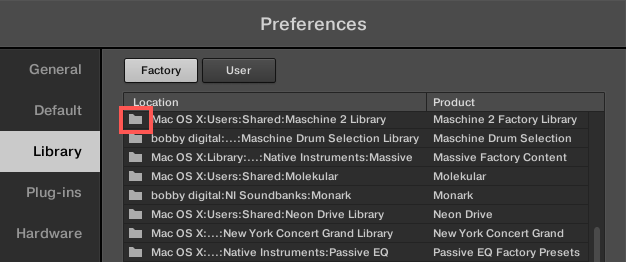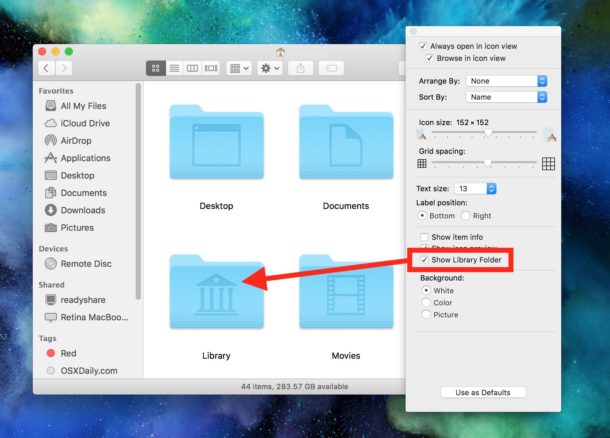Mac User Library Path
Dec 04, 2019 Type or copy and paste this: /Library/Application Support/MobileSync/Backup/ Press Return. To find a specific backup: On a Mac with macOS Catalina 10.15 or later, open the Finder. On a Mac with macOS Mojave 10.14 or earlier, or on a PC, open iTunes. Click your device. In Finder, under the General tab, click Manage Backups to see a list of your. Access Hidden Library Menu Option On Mac. Follow the steps below to access the Hidden Library Menu option on your Mac. Left-click your mouse anywhere on the screen of your Mac. This will reveal the Go Option in the top menu bar of your Mac. You can also click on the Finder Icon in the Dock of your Mac to activate the Go Option. Apr 09, 2018 macOS Library Directory Details. The Library directories are where the system and your code store all of their related data and resources. In macOS, this directory can contain many different subdirectories, most of which are created automatically by the system. Yes, it is safe. That said, don't just delete all the contents of your cache folder without reason. It can be beneficial to clear out those taking up the significant space in your /Library/Caches/ if you need to free some up, but you really shouldn't clear any contents of your /System/Caches unless there is a problem. Set Run-Time Library Path on macOS Systems. At run time, tell the operating system where the API shared libraries reside by setting the environment variable DYLDLIBRARYPATH. Set the value to matlabroot/bin/maci64: matlabroot/sys. Append library path to 'DYLDLIBRARYPATH' in MAC. Jan 12, 2020 It's not clear why Apple decided to hide the user's Library folder, but you have multiple ways to get it back: two Apple provides (depending on the version of OS X you are using) and one in the underlying file system. The method you use depends on whether you want permanent access to the Library folder or only when you need to go there.
Photos User Guide
When you import photos and videos into Photos, they’re copied to the Photos library in the Pictures folder. If you prefer, you can store photos and videos outside the Photos library (for example, in a folder on your Mac or on an external drive) and still view them in Photos. Files stored outside your library are called referenced files.
Referenced files aren’t automatically uploaded and stored in iCloud, and they aren’t backed up along with the rest of your files when you back up your photo library—you must back them up manually. To avoid manually backing up referenced files, you can move or consolidate the files into your library.
Store imported files outside the Photos library
In the Photos app on your Mac, choose Photos > Preferences, then click General.
Deselect the “Copy items to the Photos library” checkbox.
Now, when you import photos or video, Photos leaves the files in their original location and accesses them as referenced files.

Find a referenced file in the Finder
In the Photos app on your Mac, select a referenced file.
Choose File > Show Referenced File in Finder.
Copy referenced files into a Photos library
You can copy referenced files into your photo library so they’re easier to back up and are automatically stored in iCloud if iCloud Photos is turned on.
In the Photos app on your Mac, select the files that you want to copy into the photo library.
Choose File > Consolidate.
Click Copy.
The Library Menu item is hidden by default on Macs, to prevent the possibility of inexperienced users deleting important files in the Library Folder. In this article, you will find different methods to reveal the hidden Library Menu and access the Library Folder on your Mac.
Access Library Folder On Mac
The Library Folder on your Mac contains Preference Files, Caches, and Application Support Data.
While regular Mac users may not find the need to access the Hidden Library Folder, advanced Mac users will at times come across the need to access files inside the Library Folder for troubleshooting and other purposes.
One example of the need to access the Library Folder on Mac would be to rebuild the Database Files in the Library Folder, in order to fix Launchpad related issues like Apps Missing From Launchpad or deleted Apps showing up in the Launchpad.
Mac Os X Library Path
Before going ahead with the steps to Access the Hidden Library Folder on your Mac, you need to be aware that ~/Library Folder contains important Data and Files related to Mac User Accounts.
Note that it will not be visible when you close the folder window, but you can always get to it again using Option-Go. This method will always work and requires no system modification. How to get library on mac mavericks 10.
Hence, make sure that you are accessing the Library Folder for a good reason and you do know as to what you are trying to achieve.
Access Hidden Library Menu Option On Mac
Follow the steps below to access the Hidden Library Menu option on your Mac.
1. Left-click your mouse anywhere on the screen of your Mac. This will reveal the Go Option in the top menu bar of your Mac. You can also click on the Finder Icon in the Dock of your Mac to activate the Go Option.
2. Next, click on the Go option in the top menu-bar of your Mac.
3. While you are still on the Go option, press and hold the Option key on your Mac and then click on the Library option that appears when you press down the Option Key.
Note: Press the Alt Key in case you are using a Windows keyboard with your Mac.
4. Clicking on the Library Menu option will take you straight to the Library Folder on your Mac.
Access Library Folder On Mac Using “Go to Folder” Option
Another way to access the Library Folder on your Mac is by using the Folder Option on your Mac.
1. Left-click your mouse anywhere on the screen of your Mac to reveal the Go Option in the top menu bar. You can also click on the Finder Icon in the Dock of your Mac to activate the Go option.
2. Next, click on the Go option from the top menu-bar on your Mac and then click on Go to Folder… option in the drop-down menu (See image below).
3. In the search window that appears, type ~/Library, and click on the Go button.
This will immediately take you to the Library Folder on your Mac.
Permanently Unhide the Library Menu Option On Mac
You can permanently unhide the Library Menu Option in the top-menu bar on your Mac by using the Terminal Command. The process is reversible and you can easily go back to the default hidden Library Menu Setting by using the Terminal command once again.

1. Click on the Finder icon in the dock of your Mac to activate the Go option in the top Menu bar of your Mac.
2. Next, click on the Go option in the top menu-bar and then click on the Utilities option in the drop-down menu.
3. On the Utilities window, open the Terminal App by clicking on it.
4. Next, type chflags nohidden ~/Library/ and Press the Enter key to submit your command for execution.
View User Library On Mac
Once the command is executed, you will see the Library Option clearly visible and permanently unhidden in the top menu-bar of your Mac.
As mentioned above, you can always go back to the default hidden Library option on your Mac by executing a simple command in the Command Prompt Window.
1. To hide the Library option, type chflags hidden ~/Library/ in the Command prompt window (See image below)
Restore photos for mac library from exported folders to windows 10. In Photos on your Mac, export photos, videos, and slideshows so you can import them into another app to view and work with them. You can export photos in the original file format in which they were imported into your Photos library. A Live Photo is exported as two. However, nested Photos app albums are easily exported to folders using an app based on an applescript conserving the albums’ original names. The app is working on macOS High Sierra 10.13, macOS Sierra 10.12, Mac OS X El Capitan 10.11 and Mac OS X Yosemite 10.10. How to export albums to nested folders with macOS Photos app. Note: If you use iCloud Photos and you restore the System Photo Library from a Time Machine backup, any photos you’ve deleted since the last Time Machine backup are restored to your Mac and uploaded to iCloud again.If you chose to optimize Mac storage, Time Machine may not have a backup of your originals. However, the originals are stored in iCloud.
2. After typing the Command, hit the Enter key on the Keyboard of your Mac to execute this Command.
Mac User Library Path
Once the Command is executed, you will see the Library Menu option becoming hidden.